The legendary Yamaha NS-1000M loudspeaker is an iconic design that, in many ways has almost no peers even today, 50 years on.
Yamaha’s NS-1000M is lauded by those who have heard them and loved by many thousands of owners, who, like me, appreciate their unique attributes. I own the pair of NS-1000s featured in this article, purchased locally after searching for many years. They form the basis for this review, but I’ve heard and serviced many pairs and can confirm that these are remarkably consistent, unit to unit.
Article updated January 2023!
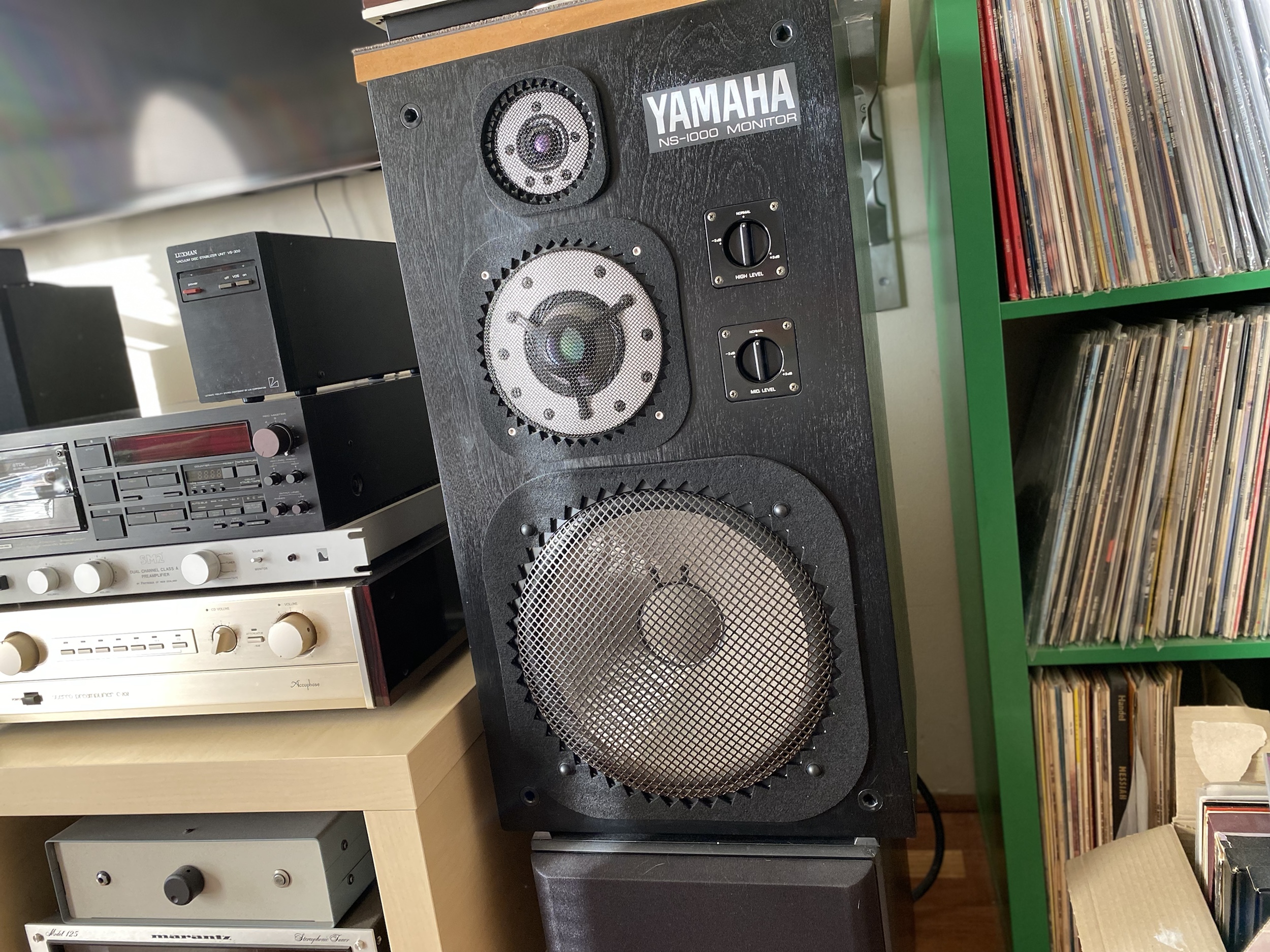
Introduction
All products are a set of compromises. Audio equipment is no different, some of it being more heavily compromised than others. That being said, the Yamaha NS-1000M contains fewer compromises than most loudspeakers. Indeed, the NS-1000M is one of the least compromised designs ever produced for the mass market.
One tell-tale is the price. In my January 1979 copy of Audio magazine, the Yamaha NS-1000s are listed as retailing for $1,450 USD. That was a heck of a lot of money for a pair of speakers back then and, adjusted for inflation, this equates to about $6,000 USD or about $10,000 AUD now. Cheap Japanese speakers, these were not!

Compromises
So, what are the compromises in the NS-1000M? Well, their size limits the bass extension possible. Yamaha chose a sealed box design for tight, phase-accurate bass that gradually rolls off, but there isn’t much available sub 40Hz. What bass there is though sounds phenomenal.
Sound pressure levels are limited by sensitivity and power handling, due to the voice coil design. They play loud, trust me on that. The 50 Watt limit is conservative and Yamaha actually removed this note on the back of later production NS-1000s. I run mine at the end of a 500 Watt per-channel MOSFET amplifier. They sound sublime and never stressed, one just needs to be sensible.
In terms of cabinet design, the large front baffle reduces imaging accuracy and the sharp cabinet edges exacerbate cabinet edge diffraction effects, which can lead to harshness and lack of precision. Most of these factors can be reduced by careful placement and the use of felt anti-diffraction materials for example.
History
The Yamaha NS-1000M hit the market in 1974. Imagine the reaction, everything was brown when these beautiful black monoliths appeared in stores. The NS-1000M is at once timeless and space-age in appearance.
Yamaha’s flagship speaker enjoyed a huge production run, for good reason. Manufacture of the NS-1000M continued until around 1984. My pair has matching serial numbers in the 60,000 range but I’ve seen them with six-digit serial numbers, up to around 120,000 from memory, maybe 150,000.
Actually, I’ve just upgraded a 300k serial numbered pair, so there are considerably more of these out there than I even thought prior to focussing on these speakers some years ago.
Reception
The Yammies were widely reviewed at the time and widely adopted. The late, great J Gordon Holt wrote this for Stereophile, back in the day:
“The NS-1000s are like the class-A speakers in that they are almost embarrassingly revealing of the electronics feeding them. They sound best with the best tube-type electronics but excessively biting with most solid-state amplifiers. They also resemble the Infinity SS-1A in that they can become irritatingly strident if used in an acoustically bright listening room.
Perhaps they are not everyone’s cup of tea even in an average room, but they can produce some of the most golden, blatchy sound from trombones of any speakers we have heard, and it must be remembered that trombones are the instruments that give an orchestra its power and drama.”
JGH
More recently, The Vintage Knob added this great page on the NS-1000M and there are loads more, all over the web.
Versions
This classic stand-mounted monitor came in two versions. The NS-1000M features a black ash veneer and weighs 31kg. A more up-market version called the NS-1000 comes in a rosewood veneer and features an even heavier 37kg per box.
The Yamaha NS-1000M sprang from Yamaha’s wish to create a premium monitor-style loudspeaker for home and studio use. The goal was a design that raised the bar in terms of neutrality and resolution.
By definition, monitors are references, used when mastering and monitoring the mix in recording studios. The goal is to make sure the mix is right and that it will sound right on really good equipment. To achieve this, the NS-1000M features several design considerations that make them extremely desirable for use in a home hi-fi system.
Beryllium
Yamaha had all the R&D and resources necessary to create the world’s first beryllium dome drivers, for use in the midrange and treble drivers of the NS-1000M. Why beryllium? Because it is the stiffest and lightest material available for loudspeaker dome design. Stiffness and lightness translate into higher sensitivity, faster transient response and better retrieval of fine detail.
These great dynamic attributes help create the incredible air and detail these speakers are known to produce. It is incredibly hard to manufacture and work with beryllium, but its unique properties imbue the NS-1000M with a unique sound.
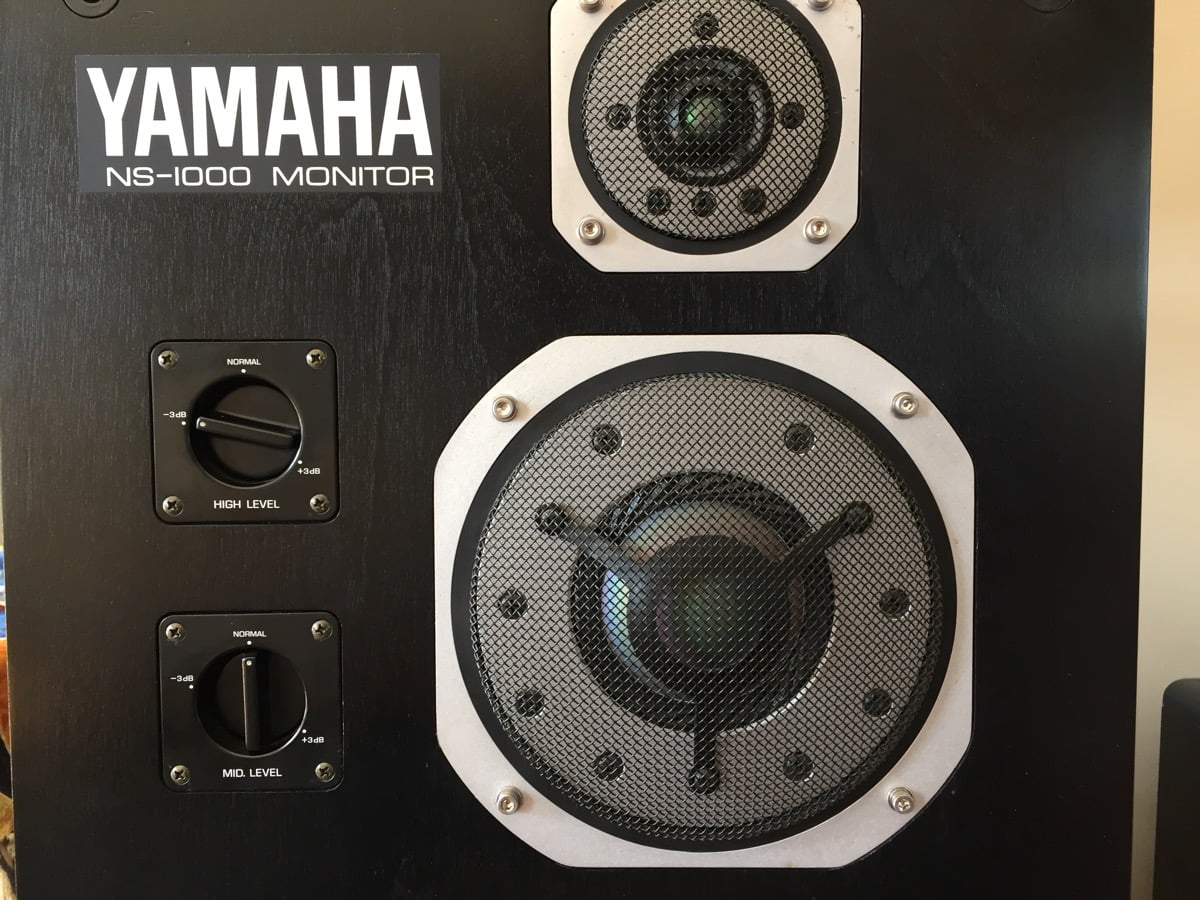
Cabinets
Whilst vented boxes are more efficient, a well-designed sealed box will have tighter bass and a gentler 6db per octave roll-off below the resonant frequency of the bass driver and box. With room gain countering this gentle roll-off, the bass response of the NS-1000 can actually be quite impressive.
The typical in-room response is very tight and clean. A sub-woofer can very nicely augment the bottom end of the NS-1000M, with the sealed boxes of the Yammies yielding tight bass down to around 45Hz. These days, I have mine sitting on custom B&W ASW-2500 700 Watt subwoofers. They augment the bass quite nicely…!
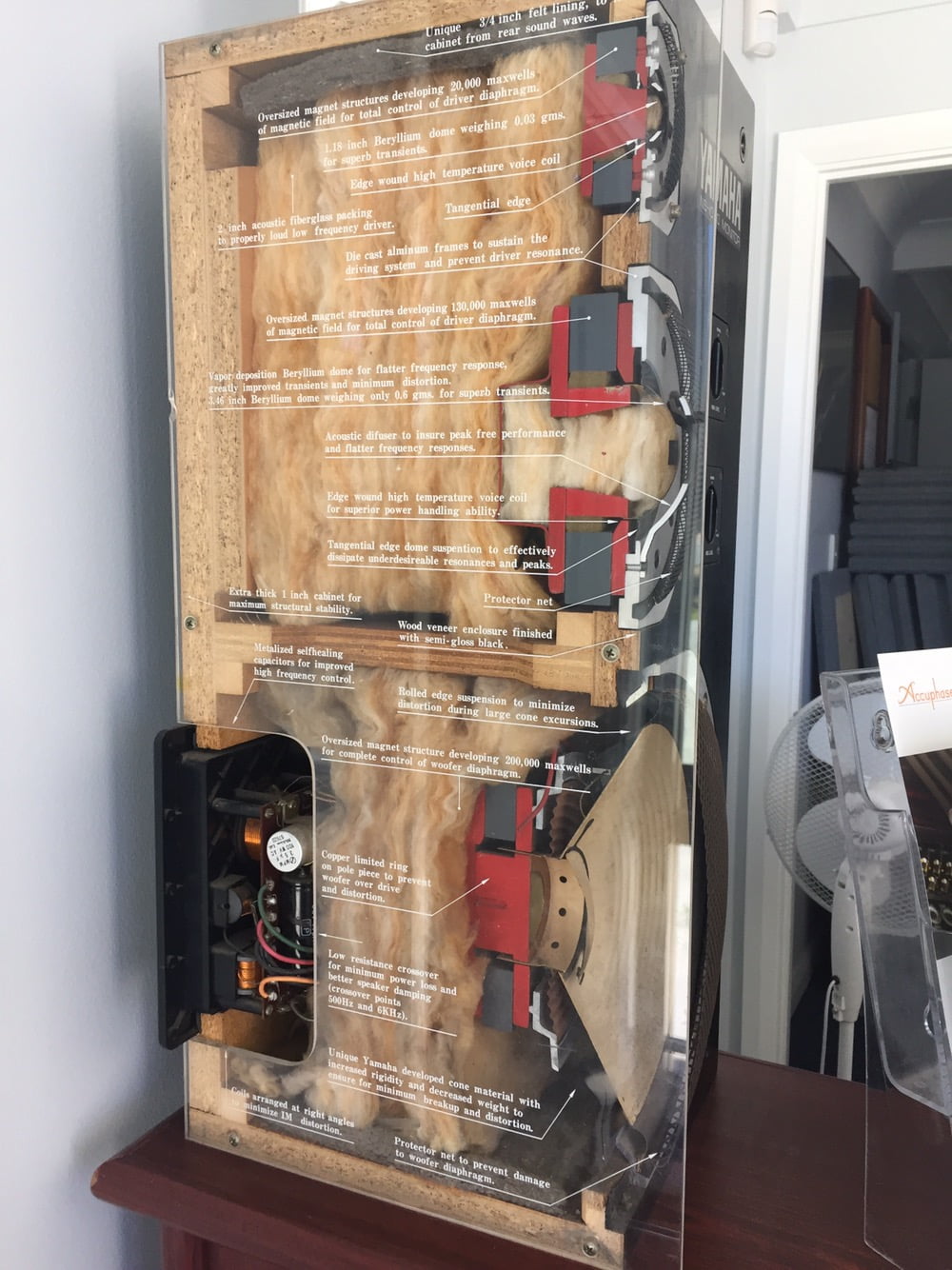
Yamaha utilised extensive internal bracing, fillets and cabinet damping materials. They even used the offcuts from cutting out the holes for the woofers to brace the cabinet behind the critically important midrange driver. This approach yields a cabinet of almost ridiculous density. Every time I lift an NS-1000, and it’s irritatingly often, I wince at the sheer mass and density of these black monoliths. Pro-tip: bend at the knees, not the lower back with these babies!
Distortion
Yamaha designed and manufactured all three NS-1000M drivers. They didn’t rely on third-party parts or designs and were able to customise these drivers to perfectly suit the NS-1000M. This rarely happens now, drivers are almost exclusively supplied by Scanspeak, SEAS, Morel, Vifa, Peerless etc.
All three drivers in the NS-1000M have large magnet assemblies, especially the midrange driver. The large magnets provide a very high magnetic flux density. This, in turn, means the drivers are quite sensitive, which means the speakers don’t need a lot of power to play loud. They do however need a fair bit of power to control them properly.
The high sensitivity and good power handling, aid the speaker’s fine detail retrieval and help reduce system distortion. The combined effect of the highly linear motors and lightweight cones and domes means that these speakers exhibit extremely low distortion across the spectrum. In fact, in a famous test conducted by HiFi News back in the day, of all the loudspeakers tested, the Yamaha NS-1000M exhibited the lowest overall measured distortion.
Crossovers
Yamaha engineers understood the importance of the NS1000M crossover network and they designed it with few compromises. Crossovers sit directly on the rear terminal block. They feature large iron-cored inductors that are unlikely to saturate and non-polar paper-in-oil capacitors feeding the midrange driver.
Slopes are all second-order, which minimises group delay and phase inconsistencies. The midrange and tweeter are wired out of phase, relative to one another. This improves the dispersion and reduces cancellation effects near the cross-over point. The series high-pass electrolytic capacitor feeding the tweeter and the large electrolytic capacitors in the bass network are less than ideal. More on these shortly.
Protection
One thing that might not look particularly aesthetically pleasing, but which usually preserves the condition of those amazing drivers in the NS-1000Ms are the driver guards protecting each driver. The delicate beryllium domes of the midrange and tweeter are rarely damaged because of this excellent driver protection.
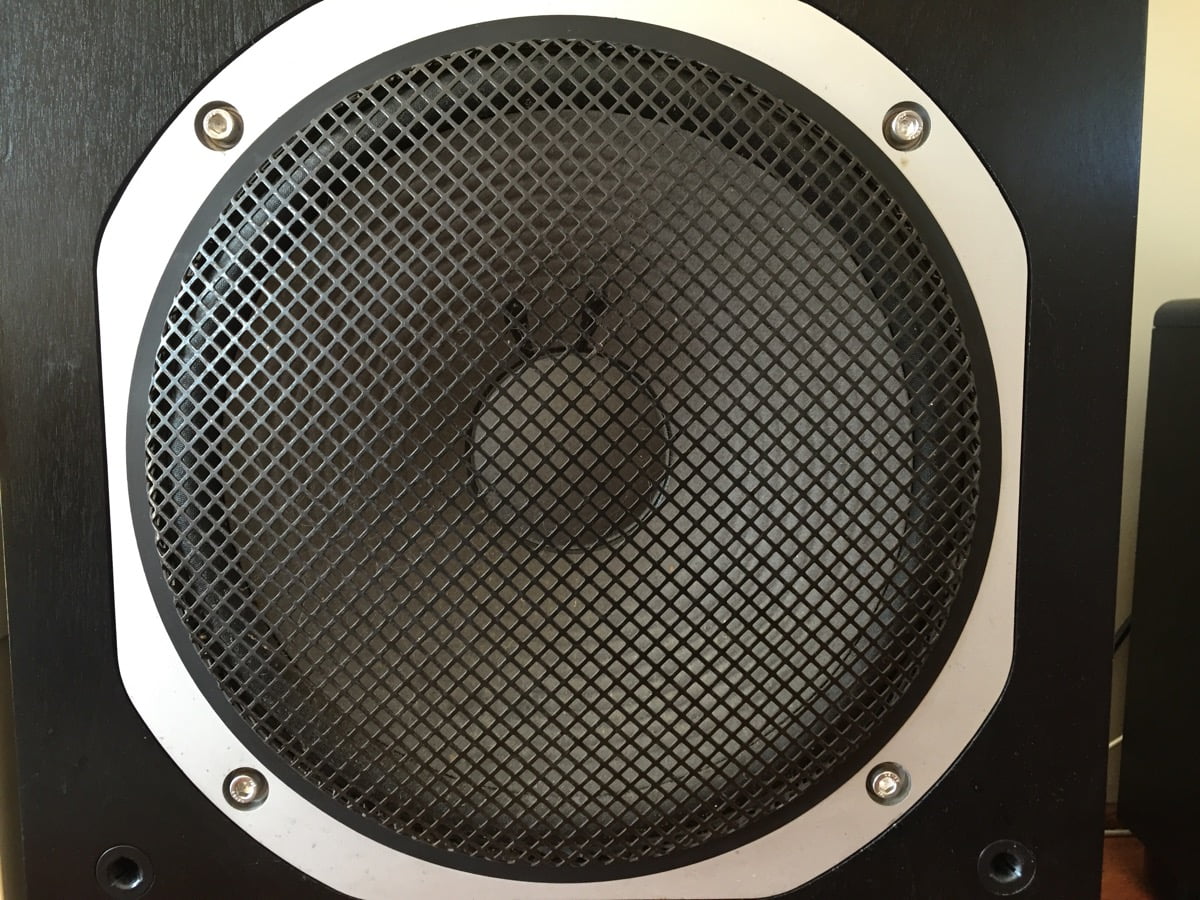
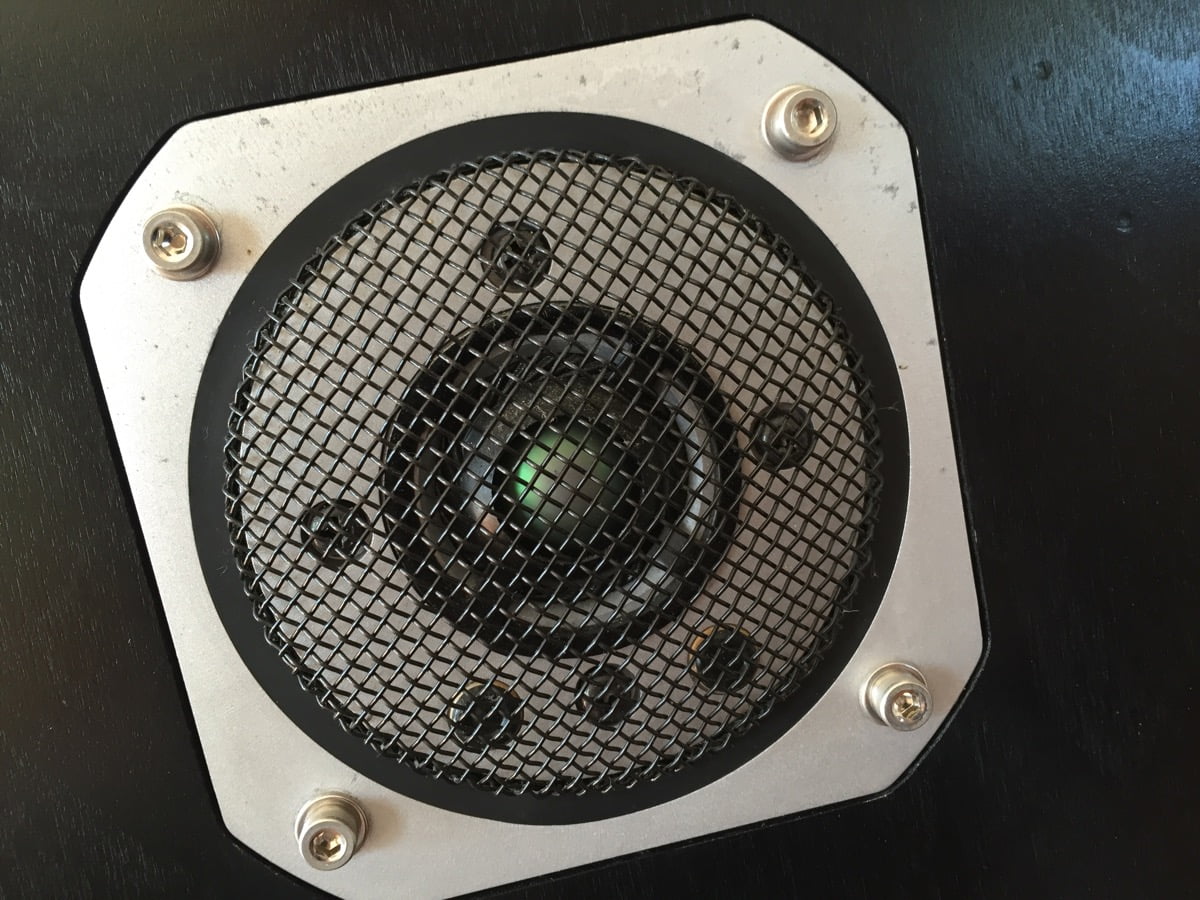
Contrast this with the NS-1200 for example, featuring very similar, but unprotected drivers, almost always horribly dented and damaged.
That Sound!
Properly set up and tweaked, the NS-1000s sound amazing. They are airy, clean, smooth, tight, and wide open. Really good systems benefit enormously from the insight afforded by a pair of these speakers and, even without modification, these speakers sound remarkable.
The NS-1000Ms are fast, precise and have amazing off-axis performance. You’ll get a great mid and high-frequency response from all around your listening room and very little beaming. A complaint often levelled at them though is that the NS-1000Ms sound bright.
It’s true that these are brutally revealing speakers. Poor source equipment and material will sound devastatingly bad through a pair of NS-1000s. If you have a harsh-sounding CD player or bright amplifier, it will be tough going. Much of my audio setup utilises class-A amplification, and FETs and this combination certainly helps to give you a smooth starting point and takes the edge off.
Choose good recordings, played on sweet-sounding gear and these speakers will give you more of the music than you may have ever heard before. The NS-1000M certainly favours tube and MOSFET or VFET amplifiers. Wonderful synergy can be achieved, as Mr Lim of the Affordable Valve Company notes here.
Electrical Improvements
NS-1000M crossovers can be improved, to great effect and, having owned my pair for many years now, I’ve developed a series of improvements for the NS-1000s.
My original improvements focussed on everything in the signal path, starting point is the series capacitor feeding the tweeter. A modern polypropylene capacitor dramatically improves things, and that’s just the start.
I also replaced the capacitor array feeding the mids. In their place, I used precision Russian military paper-in-oil capacitors as you see below. Alternatively and updated now for 2022, I use quality polypropylene capacitors. This yields a significant improvement in performance, most notably in clarity and harmonic richness.
Finally, I replace the large bipolar electrolytic capacitors in the network feeding the bass driver. Here, I’ve used gorgeous ERO vintage parts. Now I use massive polypropylene capacitors matched to very tight tolerances.
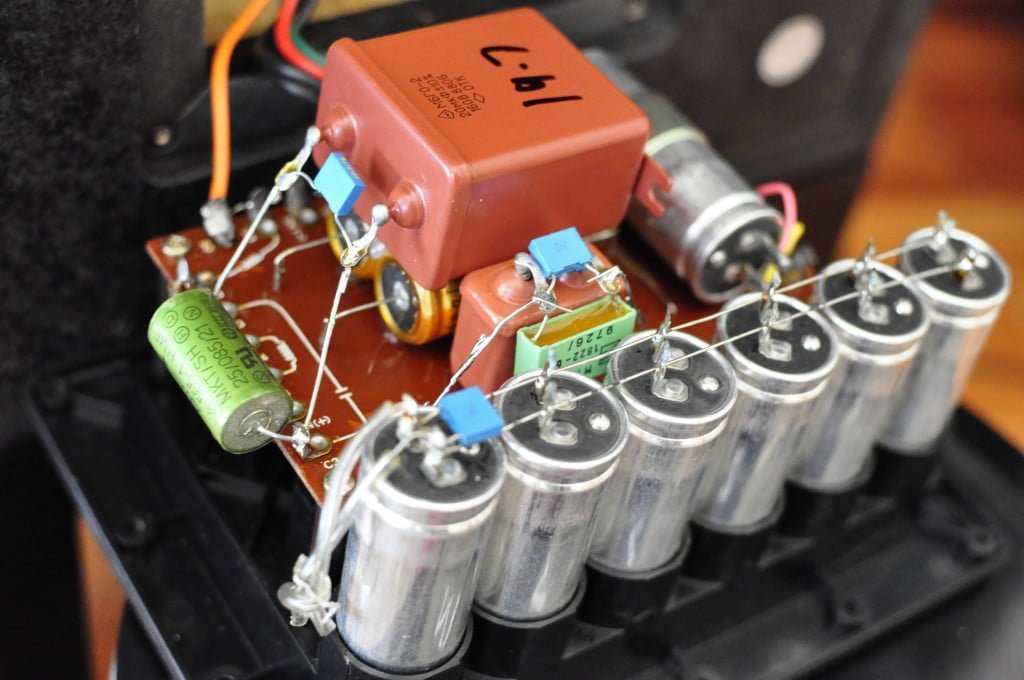

Latest Crossover Improvement
New for 2021, I’ve created a full-polypropylene capacitor crossover upgrade for the NS-1000s, using the same series of high-end Mundorf crossover capacitors B&W uses in their 801 flagship speakers.
The results are amazing, I’m blown away by the improvement in my own speakers, and the five or so sets of NS-1000s containing my most up-to-date enhancements are much loved by their new owners. One owner likes his set of improved NS-1000s more than his own pair of NS-5000s. Fancy something old being better than something new..!
The development process involved pencilling out all the numbers, taking physical measurements, ordering parts I wanted and which would fit without fouling and various mock-ups to find the best configuration, in two specific arrangements. I then built, verified and validated everything with my own speakers, before rolling out these improvements to customers.
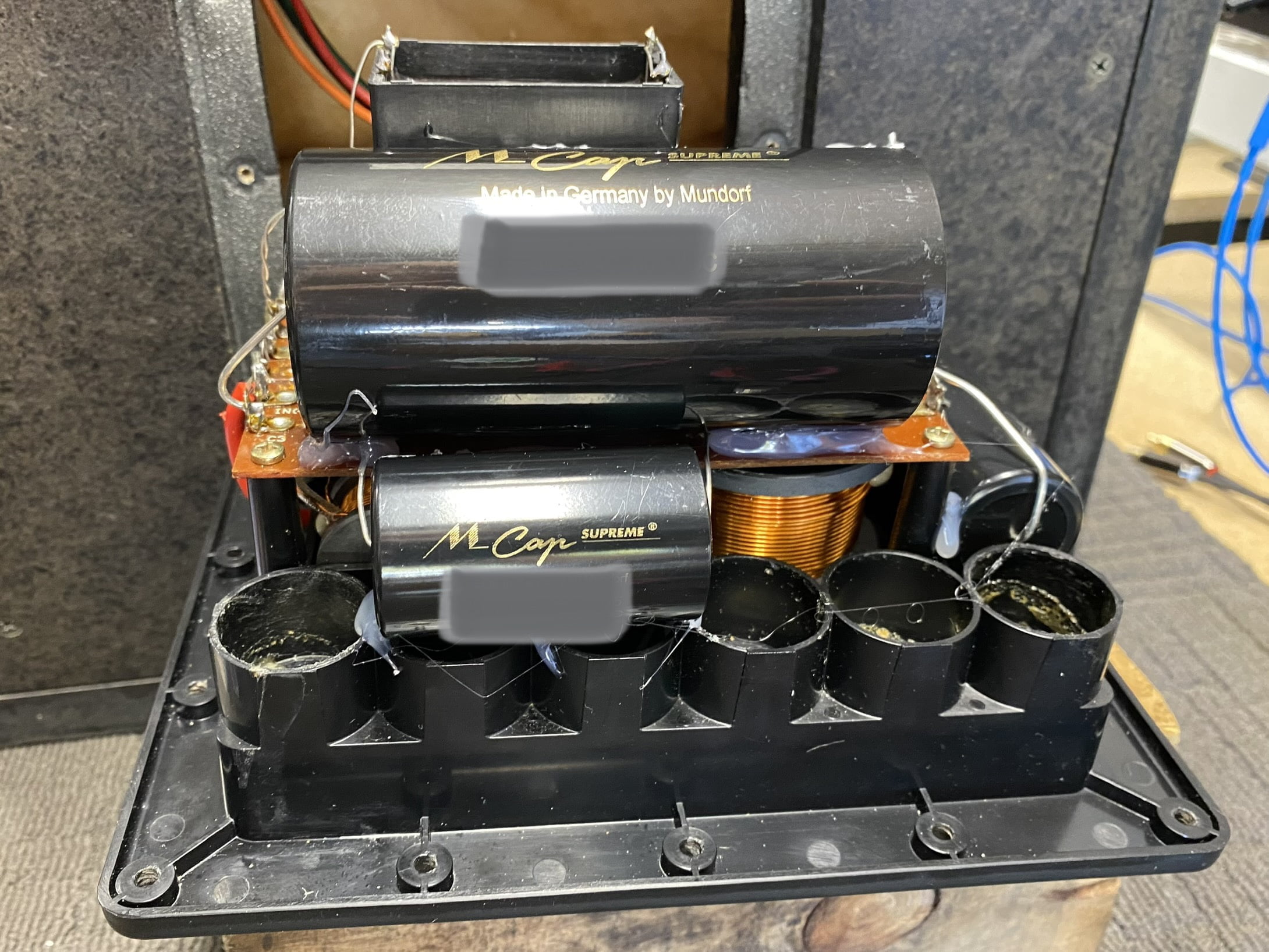
I measured, test-fitted parts, made mock-ups and trialled the capacitor removal process you see here. Everyone benefits from this work, especially Liquid Audio’s customers, and I’ve now incorporated these latest upgrades into five customer sets of Yamaha NS-1000s, the owners of which are all very happy. I have three more sets to do over the next few months, taking me into 2023.
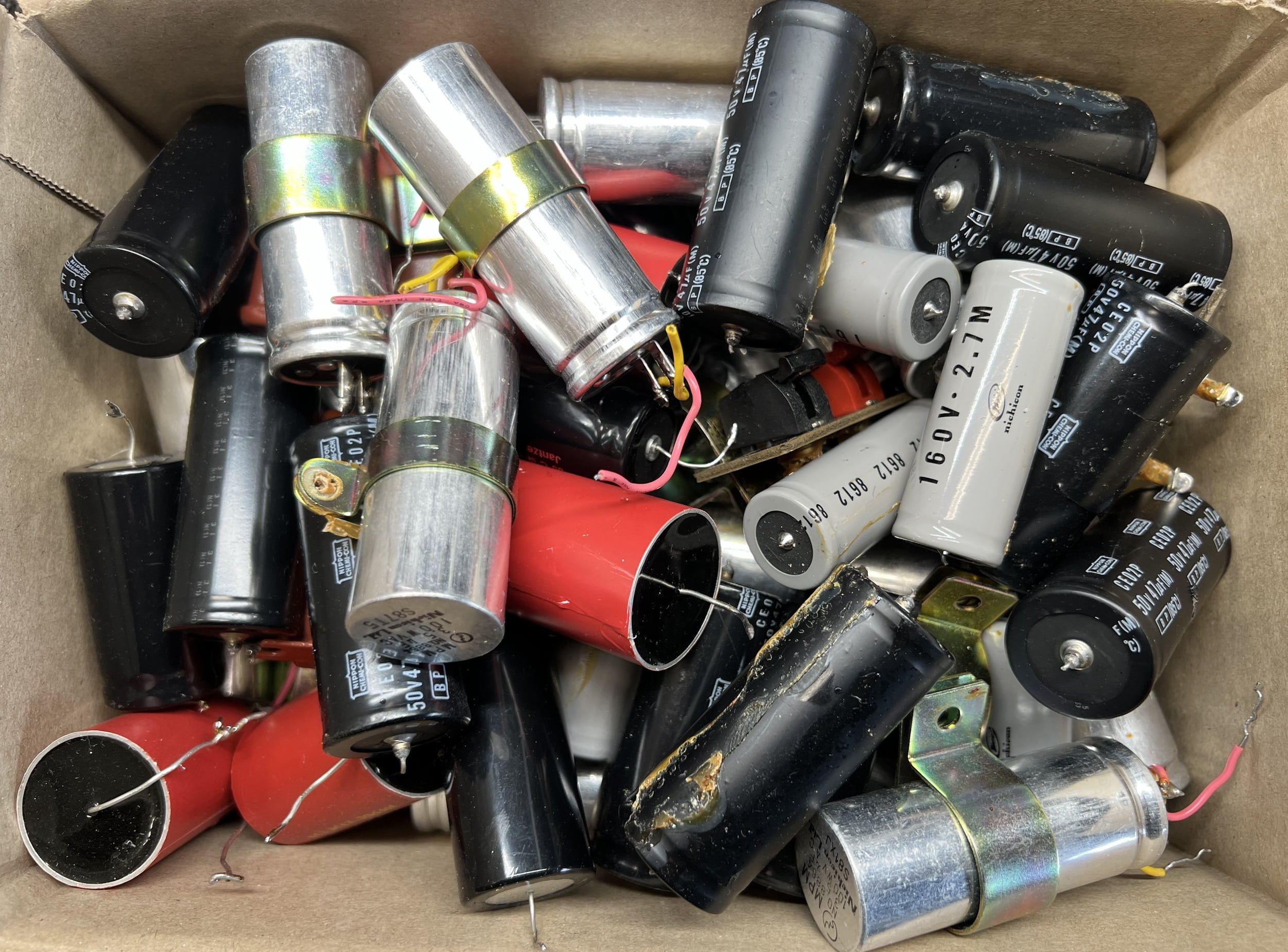
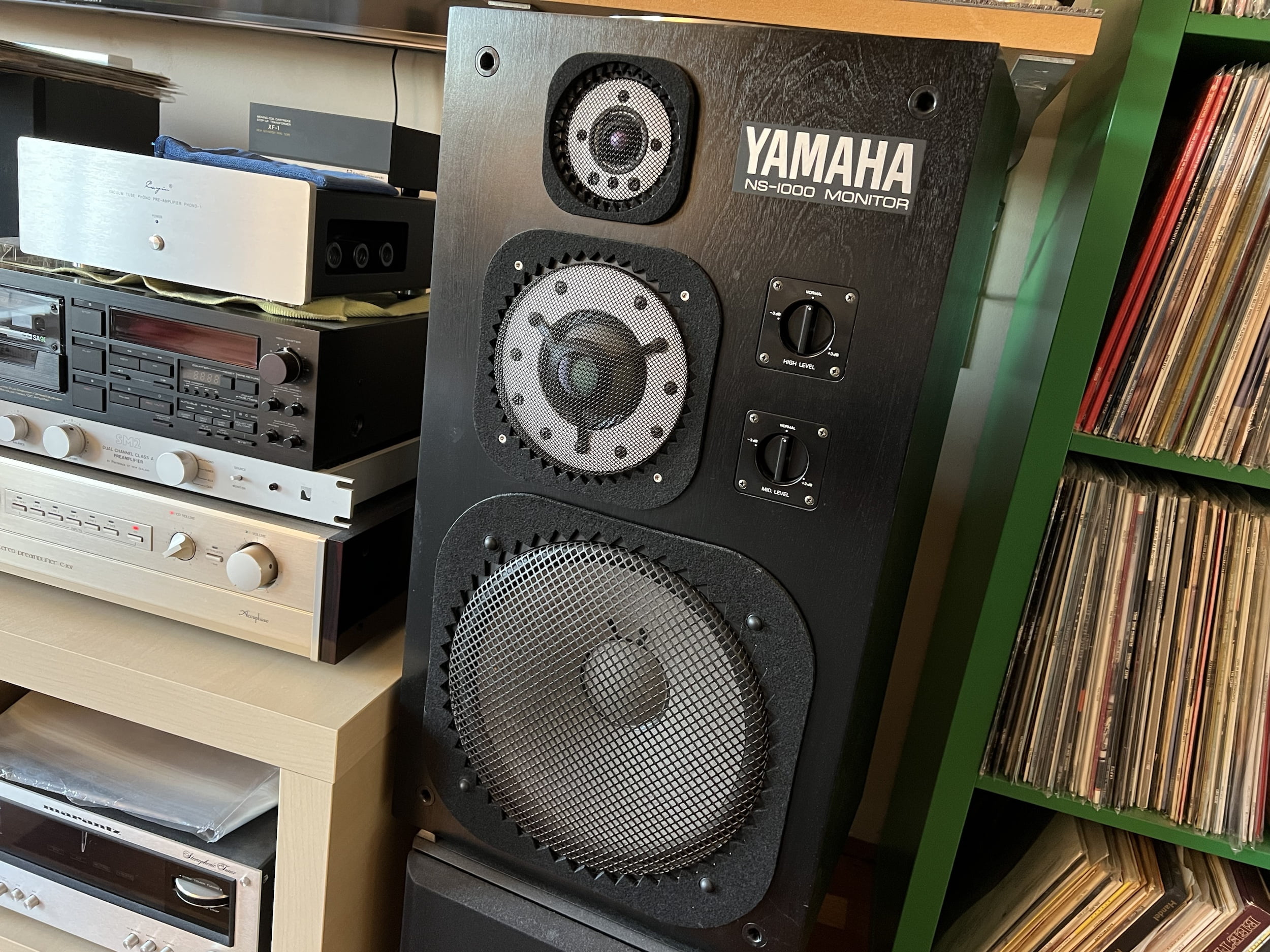
There are supply issues to consider too. Some of the capacitors you see above have been replaced by other types and I’ve even had to re-validate the design to make sure the new, new caps fit! My current NS-1000 enhancement and upgrade package V 3.0 incorporates various elements, all of which are optional according to budget:
- Complete set of ultra-low impedance, premium German and Japanese polypropylene film capacitors
- Point-to-point hard-wiring using solid-core copper wire
- Removal of existing capacitors (where possible)
- Speaker terminal and heavy-gauge OFC copper wiring upgrade
- Attenuator clean and service (very important)
- Marine-grade stainless steel driver fastener package where requested
- Various other tweaks
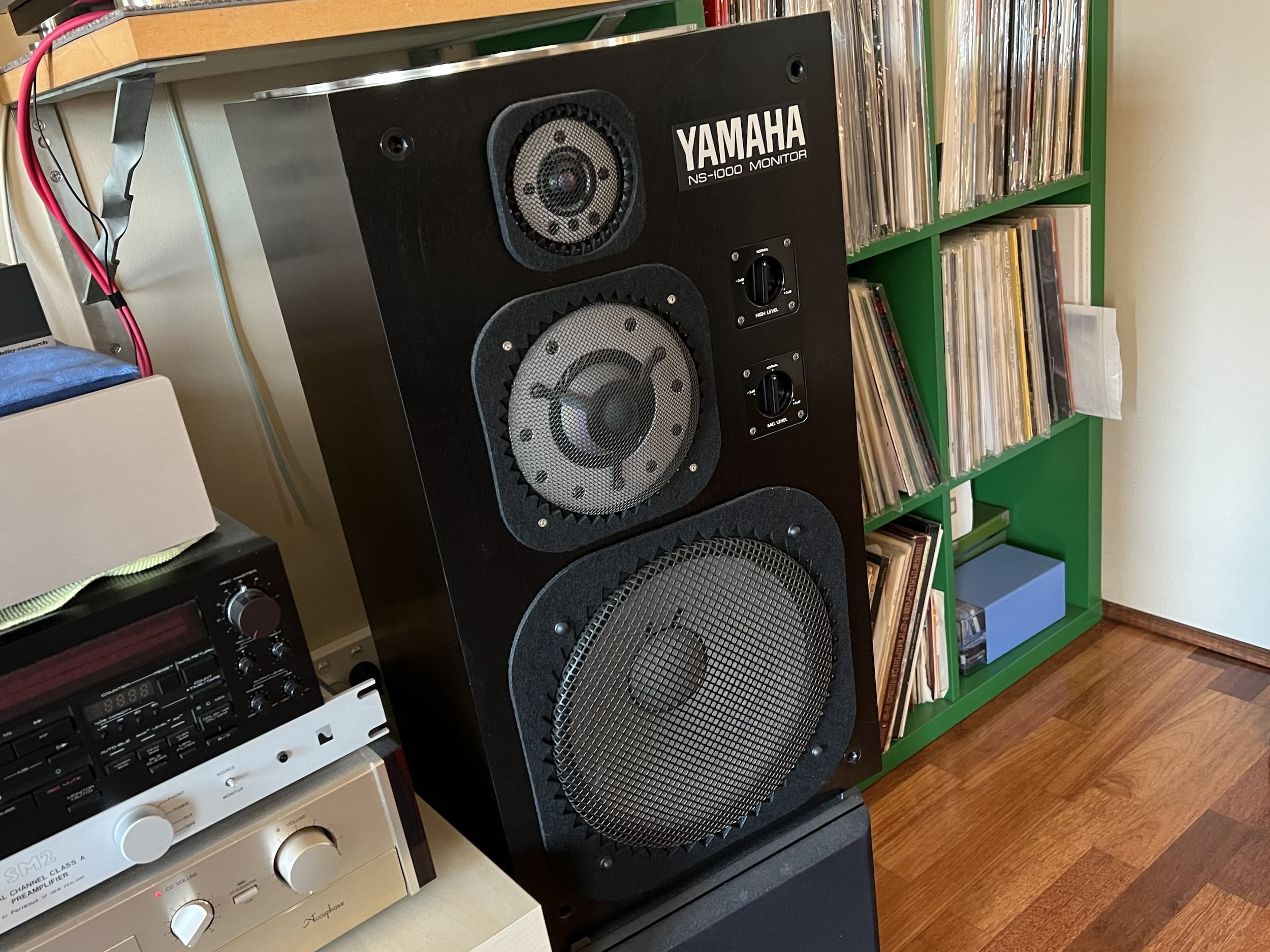
Customer Feedback
Everyone who’s heard either my own pair or their pair of upgraded NS-1000s has stated that it is a dramatic and significant improvement. Many of these customers had heard my own reference pair of NS-1000s with my version two Russian and vintage cap improvements, and even NS-5000s.
Specifically, we all report deeper, tighter bass, airer and more relaxed highs and even better midrange presence and ‘in-the-room’ realism. Everything sounds bigger, more open and more relaxed.
Here’s what one of my first full Mundorf customers had to say:
Hi Mike,
I’ve reinstalled the crossovers, they fitted perfectly, I didn’t have to alter a thing in regards to the cabinets.
I plugged them into my AS3000 to trial them and bloody hell, they sound amazing. You’ve done incredible work.
They do not scream at me anymore is a way I would describe them. Previously they were so analytical that it became fatiguing after a long listen. Now they are perfect, I will obviously let them run in like you mentioned. On my first listen though I am truly impressed.
Thank you so much for the attention to detail you clearly show in your work.
Trent R
One of my longest-standing customers and owner of several pairs of Yamaha NS-1000s just had me upgrade his already previously improved pair. These came from a refurbisher in Japan and I might add that the work done was not great, but they look pretty, so there’s that.
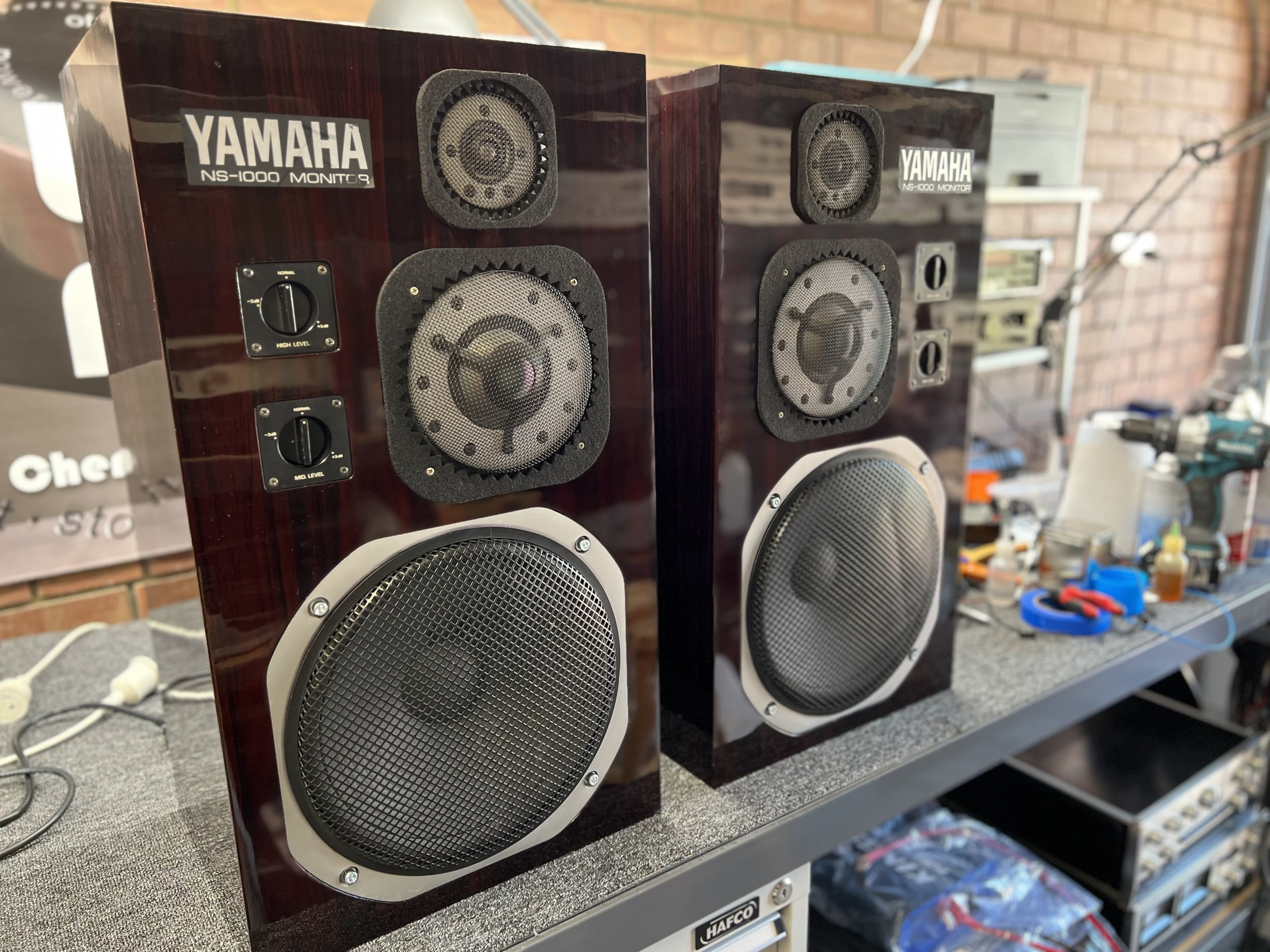
Anyway, I ripped out the partial replacement set of Jantzen capacitors and installed my complete upgrade set, plus some anti-diffraction felts. Here’s what Tim had to say:
Hi Mike
OK, so they are clearly better, across all frequencies. Tighter bass control and the highs sing. It’s a very different sound too.
You’re a genius, should have done this years ago!
Tim C
Mechanical Improvements
The cabinets are incredibly solid but I highly recommend replacing the fasteners that hold the drivers onto the baffle. I use marine-grade stainless steel Allen bolts in place of the Philips-headed screws. Allen bolts allow you to torque the drivers down tightly and offer a definite cosmetic improvement.
The factory speaker terminals are flimsy and only accept small gauge wire. I replace them with gold-plated binding posts. These fit conveniently onto the existing mounting plate and look almost like they came that way from the factory.
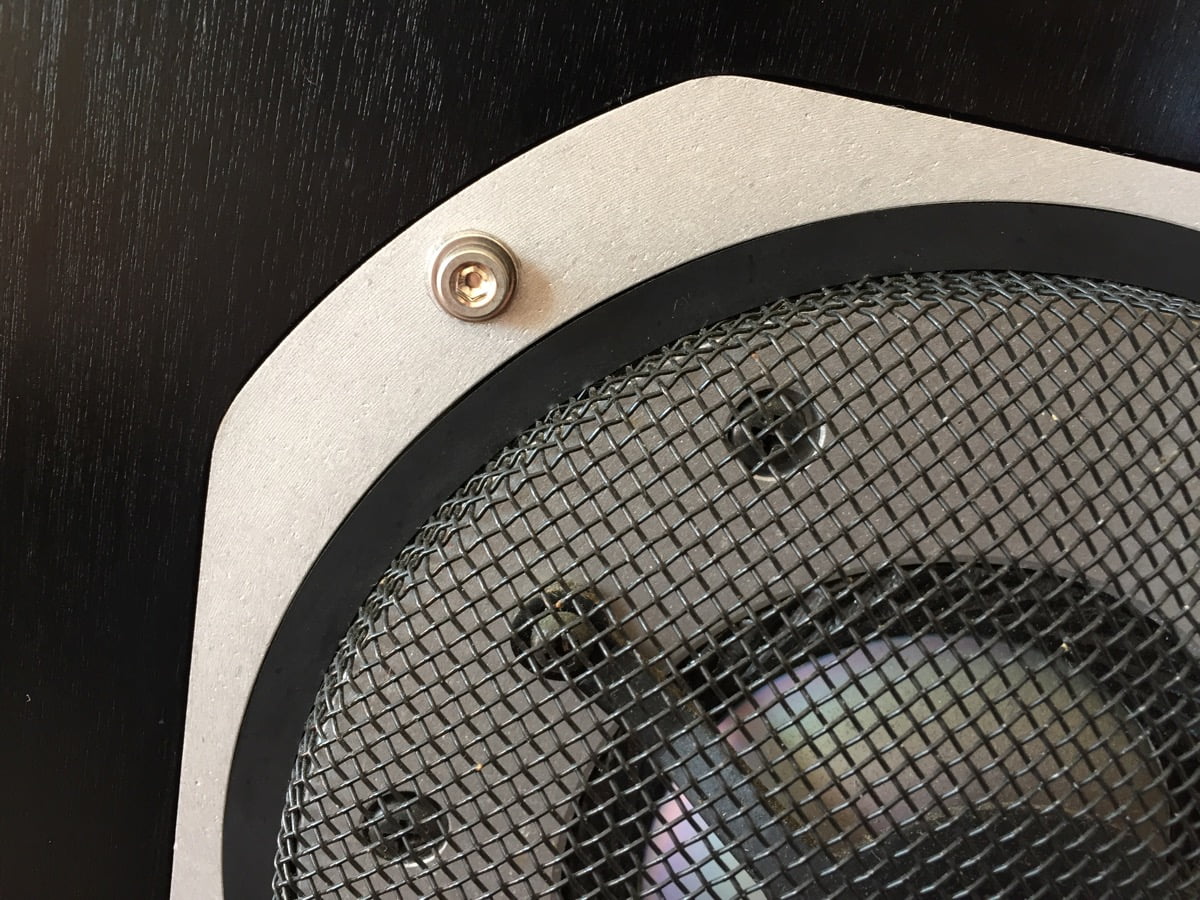
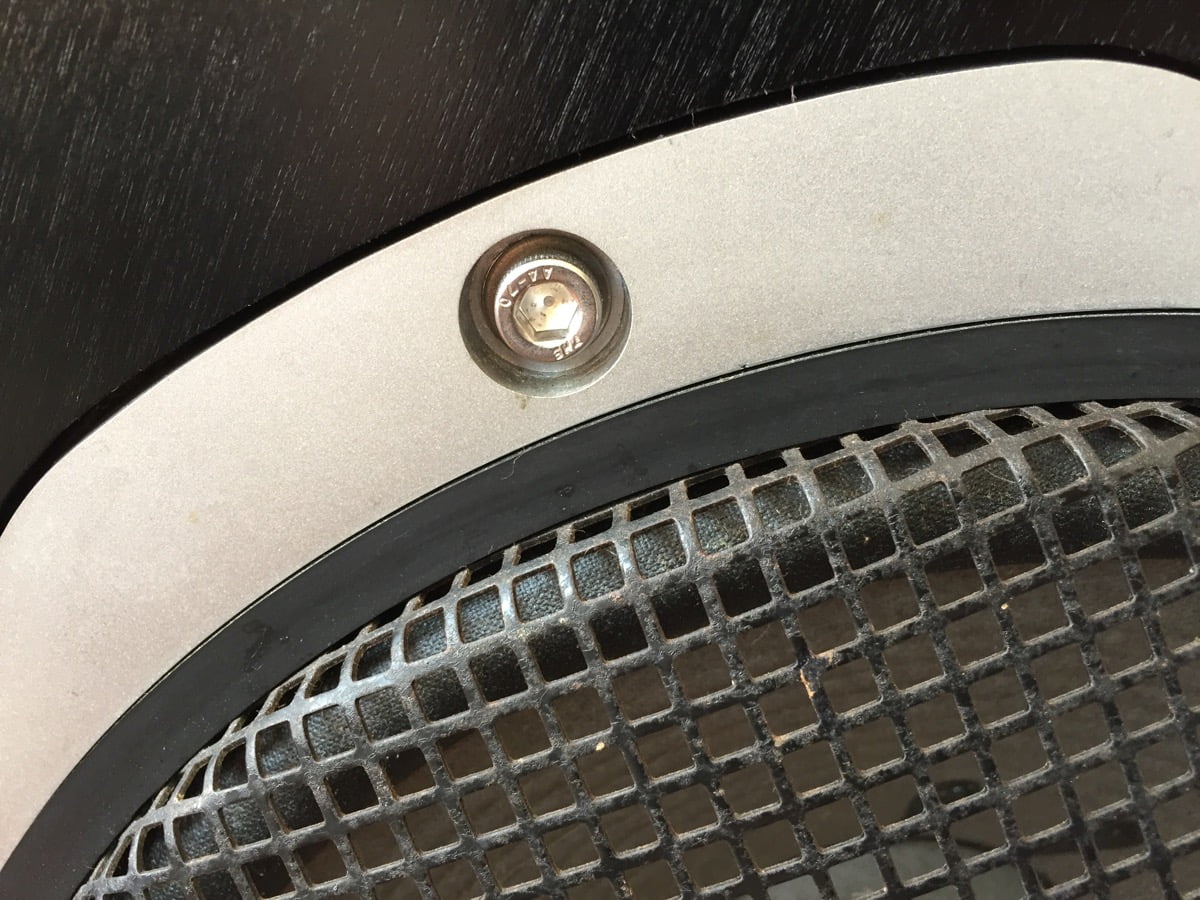
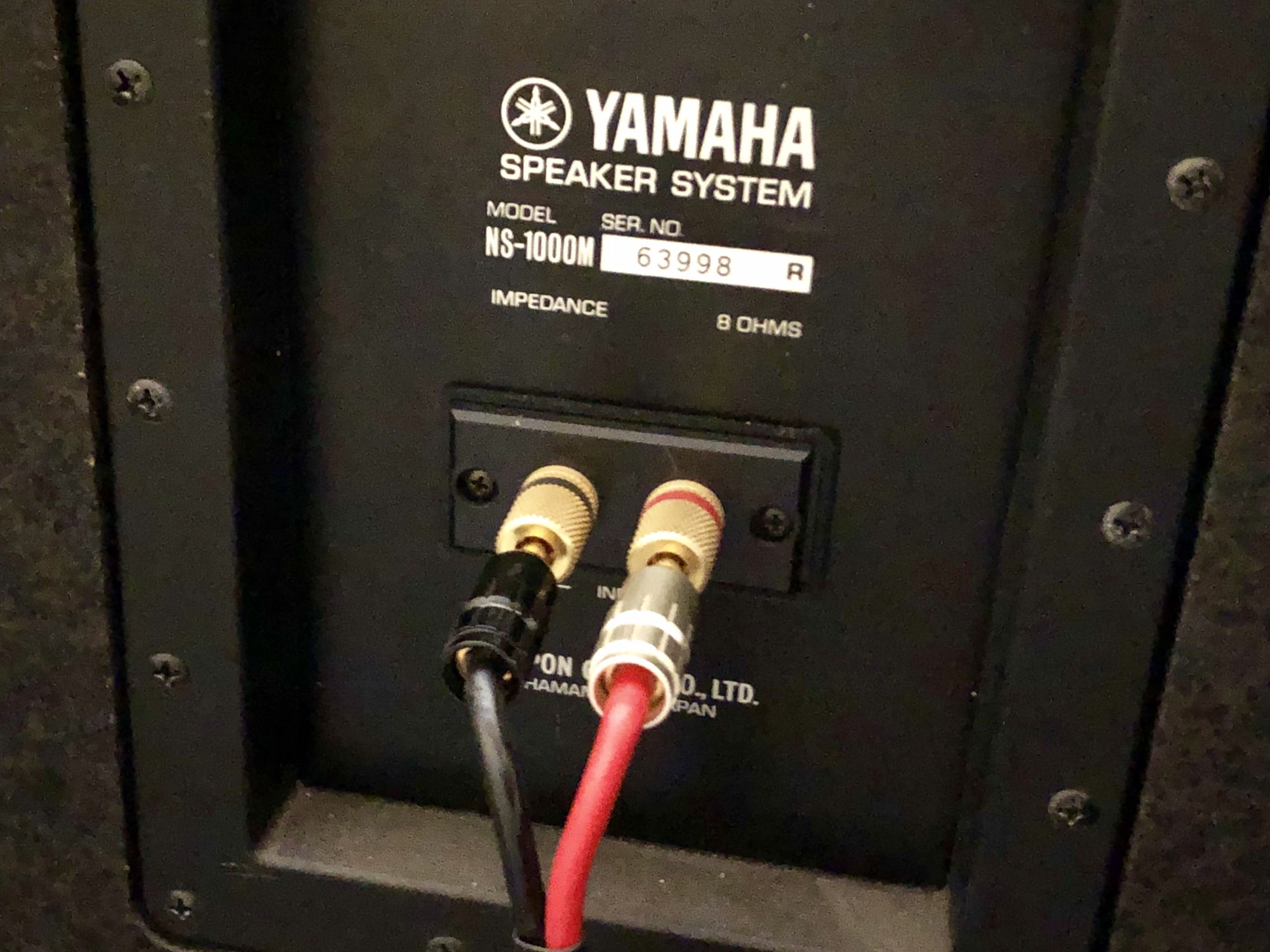
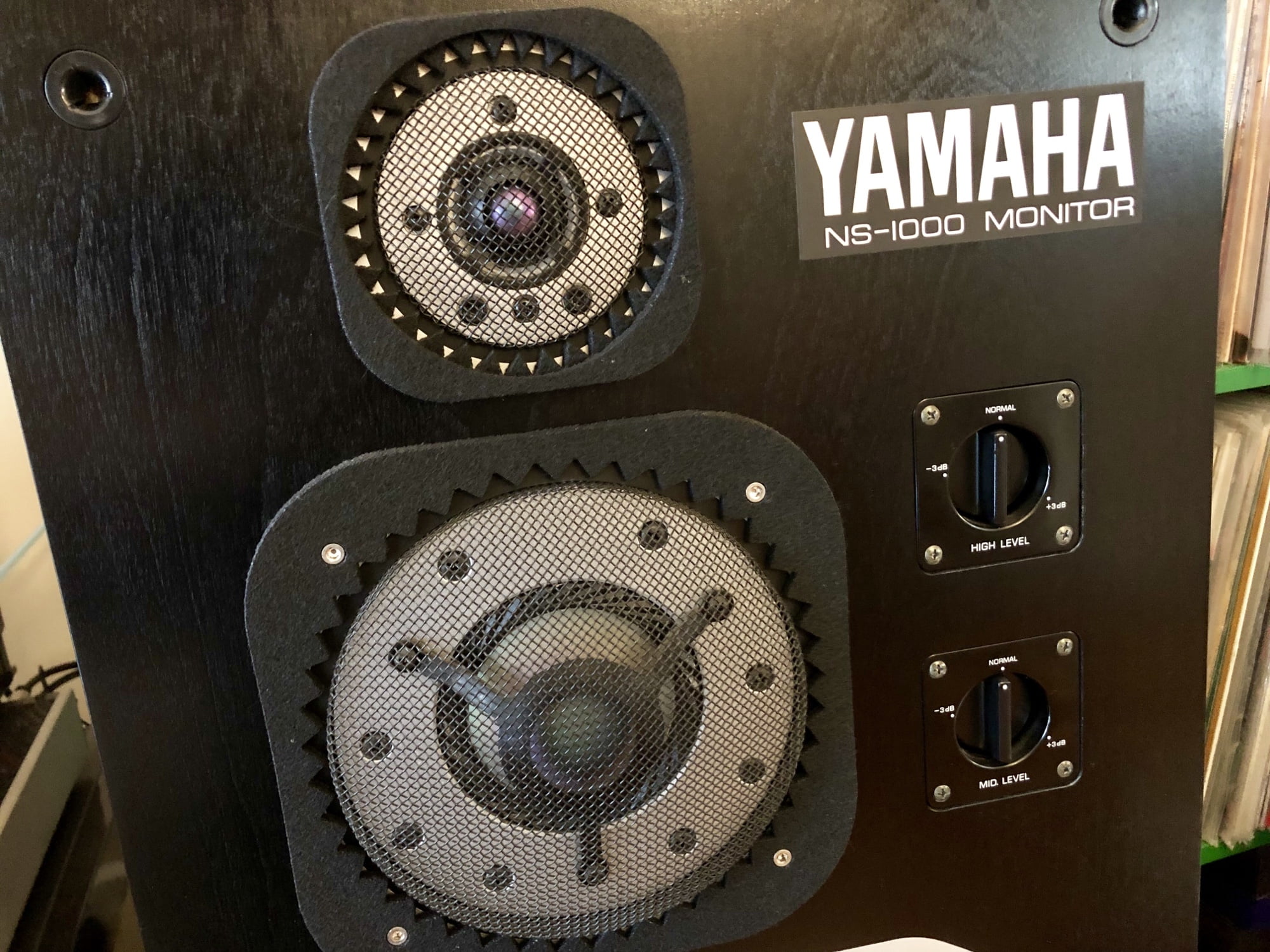

Stands
One thing you will need to get the most out of these great transducers is a good pair of stands. Stands for the NS-1000 are not easy to find. The official Yamaha stands are called the SPS-500, check them out.




It’s almost impossible to get a pair of the original Yamaha stands because owners just aren’t selling them. Instead, I decided to design and build a pair that would be easy for the average DIY’er to manufacture. I’ve written an article documenting the build of my DIY NS-1000 speaker stands, so check that out if you are looking to perhaps build your own.
The Bottom Line
Yamaha decided to resurrect the venerable NS-1000M in the form of the stunning new NS-5000, back in 2016 or so. You can read a great review here @ HiFi Choice. Loads more details may be found here. Yamaha has released the NS-5000 in Australia, with a recommended retail price of – wait for it – $ 19,999.
In engineering per dollar terms, there’s no way Yamaha could sell the NS-1000 now for less than twenty grand a pair. I would argue that the NS-5000s have a better finish, but that the drivers aren’t as good as those found in the NS-1000s. There’s too much custom engineering, metal, wood, huge magnets and dangerous beryllium in the NS-1000s to replicate them affordably.
NS-5000s are worth every bit of their retail price and, given that the NS-1000s are as good or maybe better, depending on their state of tune, you would have to conclude that for the few thousand dollars you can pick up a pair of NS-1000s for, they are the ultimate speaker bargain.
That’s certainly what I think and I don’t have any to sell you. I regularly listen to the latest offerings in the $3,000 – $10,000 price range and my NS-1000s always come out on top.
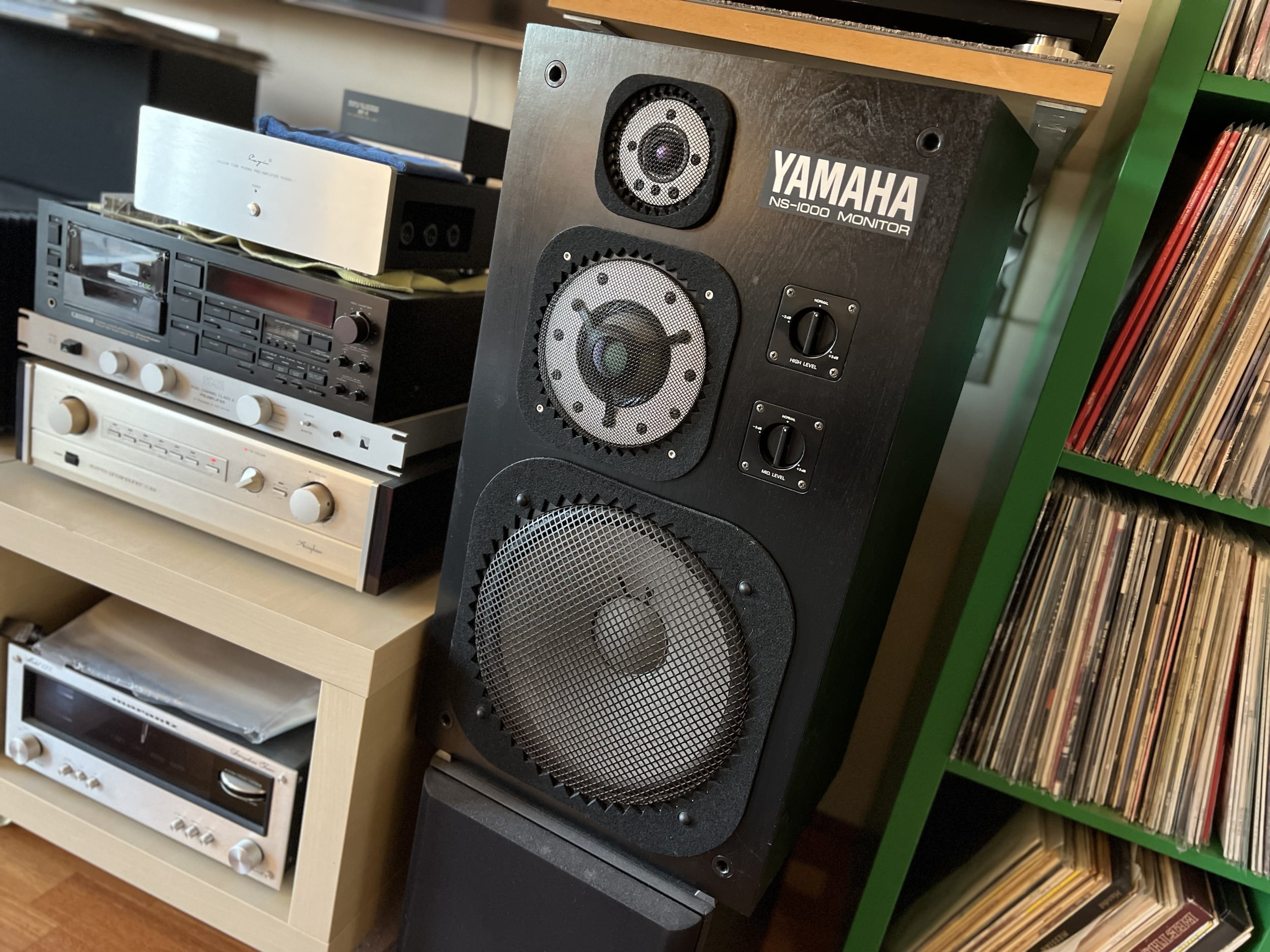
Two customers of mine have NS-5000s and they both absolutely love them. One customer drives them with an Accuphase class-A integrated amplifier. He reckons they sound amazing and I’m sure they do!
The other customer recently sent me his NS-1000 crossovers for the full Mundorf upgrade I’m offering these days. He reckons his newly upgraded NS-1000s sound better than his new NS-5000s:
Hi Mike,
I plugged them into my AS3000 to trial them and bloody hell, they sound amazing. You’ve done incredible work. They do not scream at me anymore is a way I would describe them.
Previously they were so analytical that it became fatiguing after a long listen. Now they are perfect, I will obviously let them run in like you mentioned. On my first listen though I am truly impressed.
Thank you so much for the attention to detail you clearly show in your work.
Trent R
So, if you find a pair of classic, game-changing Yamaha NS-1000M studio monitors in good condition, with undamaged drivers and matching serial numbers, grab them. Nothing for sensible money comes close. Seriously. Nothing.
Want to Give Something Back?
If you’ve found this article informative and useful in some way, consider making a donation. If you’d like advice or help regarding your Yamaha NS-1000, you can purchase an advice block or consult via our Contact page and Store.
Thanks for reading!

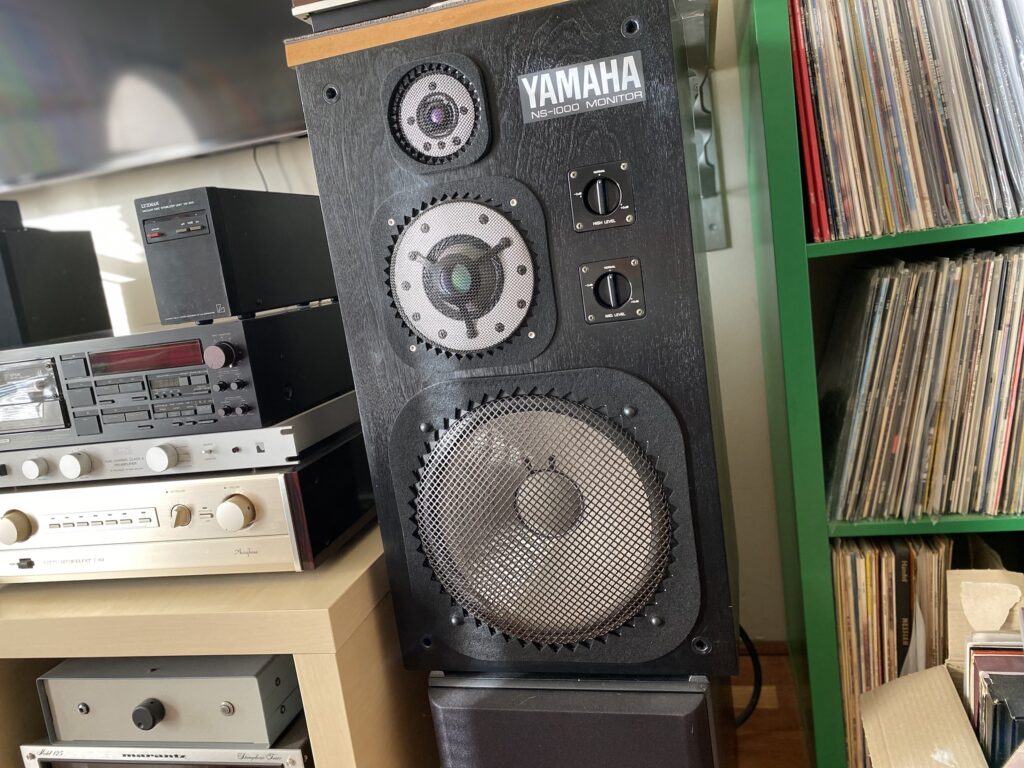
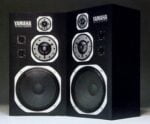
Thanks for the review. Two comments: could you elaborate on the type of caps you used to replace the electrolytics across the bass driver? Did you hear any difference with this change? Did you hear much change with the tweeter cap substitution?
Did you know that Yamaha on page 3 of their owners manual, under “Speaker Placement”, l says “The best location is one in which the speakers are placed with their backs against a hard wall.” This is contrary to what is usually done in contemporary set ups and could go some way in explaining the light bass balance so often mentioned when describing these speakers.
I recently bought a pair to mix and master recordings, on the strong advice of a very seasoned recording industry veteran, a mixing and mastering engineer since 1973 or so. He feels the amp is very important and the best he had heard the NS-1000s that he used for 30 years was with the Yamaha B-1 V-FET amp. I could not afford one of those—they still command top dollar—but what I did get is, I think, another undiscovered Yamaha treasure: a B-2 amplifier. The combination of power, sound, metering and control flexibility (and current price) make this a knockout. Think about this: the retail price in 1976 was 200,000Y, about $2500 today and a ton of money back then, yet they sold around 10,000 of them.
The owners manual for the NS-1000 suggests the B-1 and B-2 were intended to partner with the NS-1000, and it sure sounds that way. The bass is very tasty (I’m a closet bass freak).
Hi Russell, thanks for your comments and for filling out my feedback pop-up and my pleasure regarding the review.
A few comments in response to your questions. First, the replacement capacitors I used in the low-pass filters were premium EROs from memory. These are a laboratory/military grade cap and I used pairs that I tested to measure precisely 94uF, as per Yamaha specs. I did hear a difference with this change, but less so than with the changes I made to the mid and treble networks. The low pass filter is likely to change the cutoff frequency only, and these caps are not in series with the bass driver.
The tweeter and midrange capacitor changes yielded more dramatic results, as you would expect, given that these caps are in series with these two drivers. These are well worth experimenting with, especially the tweeter, as this cap is a low quality electrolytic and needs to be changed. The midrange caps are better but paper in oil replacements still made a noticeable difference.
I was aware of the suggestion to place these close to or up against a wall and this will definitely yield better bass response, though likely also poorer articulation and clarity, some experimentation is suggested here!
I’m very glad to hear that you bought a pair of these wonderful speakers and I wholeheartedly agree that the Yamaha VFET amps are a superb choice to drive these speakers. The quality of the VFET amps is well known, but the impossibility of finding any spares for the fragile VFET devices means that counterfeit items are everywhere and many amps will no longer contain original, genuine VFETs. If you have a B-2 with genuine VFETs, look after it!!
Hi Mike
Always enjoy your articles & YouTube channel. What is considered ordinary HiFi? I’m considering buying a pair & would be driving them with the following: Yamaha CA-1010, Sansui AU-717 & a Sansui AU-919. Would they be adequate for these speakers? Thanks in advance & keep up the great work!
Hi Doug, thanks and glad you are enjoying the content! The NS-1000s sound best on the end of really good, liquid-smooth-sounding amplifiers. This rules out a lot of gear, but the AU-919 would be my pick of what you have there, assuming she’s in great condition and your room and sources are suitable. There’s a range of stuff that can be done to improve the NS1000s, the listening room and the partnering equipment too of course. If you need a deeper dive into this, we also offer an advisory service, consults etc. Always happy to assist.
Greetings from New Zealand…Thank you for the review. I concur with what you had to say. One thing that you have mentioned is that the NS 1000M can be very revealing – especially in the midrange. It would be better to set the midrange control on the speakers @ -3db mark or below in a normal room. This cuts out some of the glare and actually darkens the sound to blend with the lower end of the sonic spectrum – yet the highs remain clean. This is using soild state amps – the setting will differ for tube amps. I play analogue – vinyl – and have found this extremely effective to give a clean canvass of sound across the 20Hz to 20 KHz spectrum. Happy listening…best regards…G
Hi George, yes I generally agree, though this will vary according to room furnishings, brightness and ancillary equipment. There are also issues if the attenuator knobs are ever removed, as Yamaha provided no instructions to correctly index the knobs upon reinstallation, meaning there can be unit to unit variation if these have ever been removed! Generally though, the -3dB setting is good in average and brighter suburban environments.
I believe we are moving back into the era of Hi Fi. vinyl will be the stimulus for sure. Its a just a matter of time before those buying vinyl will be experimenting with improving thier sound. Think that leaves a great opportunity for some one to move in with moderately priced systems and not high end with an attitude of education.
PS great website .
PPS should have a blog space for interaction.
Hi Ian, thanks for your kind words re my website, glad you are enjoying it. I’ve been in this space for a long time and things are certainly happening, that is for sure! I agree, vinyl has been a wonderful catalyst for the renewal of a joy for hi-fi in many people and this is just wonderful. More of it I say! Regards, Mike
Would these be a good fit with my pioneer sx 1250 reciever ? Or is it to much power for them to handle?
Hi Steve, these would be an excellent match. They are very conservatively rated for studio use in mind. I’ve been driving them with a Krell KSA-150, and they’ve never been stressed!
Hi. I congratulate you for the update you did to these great speakers. I have a question, buy a few Ns1000 recently but I want to update the Crossover, I want to know if you know where they sell the updated Crossover. Thank you
Hi Gustavo, thank you, I’ve made several very effective upgrades to these speakers over the years. I designed the changes myself, you cannot buy this crossover anywhere. A fellow called Troels designed an alternative though, you can read more about it and buy them via his website: http://www.troelsgravesen.dk/Yamaha-NS1000.htm
Hello and thank you for this well written article. I really like the appearance of your marine grade stainless steel Allen bolts. Would you be so kind to share where I could purchase them and perhaps the item number on top for both the woofers and the tweeters/midranges? Thank you!
Hi Joe, glad you like the bolts, me too. I purchased these from a local fastener supplier and I couldn’t tell you part numbers etc as I don’t know them. I suggest you take one of each size to your local fastener supplier and see what they have. If there is enough demand, I might consider selling a bolt kit..!
Hi Mike and thank you for your reply. There is a number on top of the bolt, but I just can’t quite make it out. I currently have 3 pair of NS-1000Ms, one pair of NS-1000s and a pair of NS-2000s. A buddy of mine and I also recently partnered on a pair of his retro-mod NS-1000Ms cabinets in original ash veneer and my extra components. Pretty interesting look. We definitely need these bolts to complete the look, though. Thanks again!
Hi Joe, sounds like you have some great Yamaha speakers there! The number you mention is brand and bolt spec, not part number. My best advice is to take one of each of the standard fasteners to a reputable fastener supplier and obtain stainless allen-headed replacements. These are metric of course, you may struggle in North America to find metric bolts but someone will have them.
Your ns 1000 write-up gives me a smile! I’ve a distant memory
of being a young serviceman stationed in Japan in 1976. Wanting to get some good audio gear I asked friends for recommendations. Those were the speakers suggested. I took the train into Tokyo and listened to them in an electronics store, and was impressed. Could barely communicate with the salesman, but purchased them, anyway. With some rope they provided me I carried them both back on the train, to the base. Enjoyed them there, and shipped them when I returned to the US. Since then, they’ve moved many times around the US. All the other audio gear from those days eventually wore out. I was thinking these were sounding a bit dated until last week when I replaced and old receiver for a new yamaha av model. OMG, they are again sounding amazing. I was curious if they were still available and what other’s experience with them was/is and I came across your post. As a musician and music producer, I’d say they are still the best purchase I ever made. These days, I’m lucky to carry one of them at a time. With the exchange rate then, and getting them in Japan, I paid about a third of what they would have been in the US. As long as my ears are working, I’ll likely keep them. Thanks for the nice info on fixing them up, when necessary.
Hi and thanks for your comment. What a great story and yes, I think many people now realise just how incredible these speakers really are. Ground-breaking in many ways and with no real modern replacement. With a little TLC, they can be made to sound even better and I’m sure your pair will continue to give you the same musical enjoyment and insight mine give me.
Salve. Anche io posseggo una coppia di NS1000M comprati nel 1987 . Pero sono saltati spesso i tweeter (due volte, visto il costo li ho sostituiti con dei Pioneer economici per tamponare) ed ora è partito un Woofer. Sono pilotati da un amplificatore Yamaha AX-792 . Giuseppe1964
Translated: Hi. I also own a pair of NS1000M bought in 1987. But tweepers often skipped (twice, given the cost I replaced them with cheap Pioneers to buffer) and now a Woofer has started. They are driven by a Yamaha AX-792 amplifier. Giuseppe1964
Hi Guiseppe, thanks for your comment. My Italian is not good I’m afraid so I’ve translated your comment for my mostly English speaking readers. It sounds like you are having issues with your NS1000Ms. These tweeters won’t ever blow unless they are overdriven, so look carefully at your setup and practices. I hate to say this but an AX-792 is way below what you really ought to be using with these amazing speakers. I’d seriously consider an amplifier upgrade, plus look at the room, source, music and way you listen. For example with lesser gear, or inexperienced ears, people sometimes turn up the bass or use loudness controls. This will almost certainly overdrive them as the volume is turned up. I’ve had mine for 6 years and use a 500 watt per channel amplifier of extremely high quality and I’ve never had an issue. With the right gear and listening practices, driver failure simply should not happen. Ciao, Mike
Hi Mike,
I’ve been reading your page very carrefully and couldn’t agree more on the fact that these are incredible speakers.
I run them with a M-/C-2A coule and the whole sounds absolutely amazing.
I’ve looking on the internet for crossovers imporvement since a while now.
Yous sounds very easy and efficient ones!!
Would you be so kind to give more details about the modifications you’ve done and the capacitors (brands, values) you’ve used?
I would love to get my pseakers to you to get that job dnoe, but France is a long way to you…
Thank you very much and have fun!!
Arno
Hi Arno, thanks for your comment and glad you enjoyed the article! I’ve had a few similar queries, unfortunately, as a rule, I don’t give out parts lists, sell kits and so on. There are many reasons for this, one being that I provide these upgrades as a paid service for my customers and so I need to consider keeping some of my work, developments and IP etc up my sleeve! Another issue is the NOS/mil parts I used in these crossovers, many of which are hard to come by. That being said, I will probably update the NS-1000 article again sometime soon and provide a more detailed breakdown of what I did in this case. People seem to want this type of content!
My pair are serial# 27,785 🙂
Nice!
Also love the article… this re-capping, at least to some extent, looks like a project I’d be interested in 😀
That’s great and there are many options to consider here. I’ll do an article on an improved set of crossover mods at some point that might be of interest to the NS1000 community I think.
Hi Mike. Great review. I just inherited a pair of 1000m but woofers and tweeters are shot, midrange is ok. Could you advise on replacements woofers and tweeters? Thanks, Ernesto
Hi Ernesto, glad you enjoyed the review! Drivers are no longer available new and so must be repaired by a very competent speaker repairer. Find the best person in your area to work on these.
Thanks for the advice! Have a great day
My pleasure Ernesto!
Hi Mike,
I happened upon your site whilst exploring comments on the Yamaha 1000M. I have a chance in the next couple of weeks of buying a pair. They are the studio monitors, the ones without the
front dust-covers. My question concerns the compatibility. I have a pair of Icon Audio 845Ms partnered with Icon’s PS3 MK11 phono stage and their LA3 pre-amp – but my room is only 13′ x
13′ sq.,carpeted, heavy curtains and one wall lined with albums. I don’t play loud and my choice is jazz, big band vocalists, classical and – even old-style country music. Will I get full
frequency at low to moderate volume? Most of my albums are pre 1980.
Don’t mention the Ashes!
Regards,
Brian
Hi Brian, glad you found the site! Specific advice relating to your system and setup can be sought via my Contact page, but briefly, the NS1000 has excellent bass performance and is reasonably sensitive, so it will perform well with many amplifiers, yours likely included. The speakers typically need attention at this age and there are various improvements that can be made to them at the same time. Happy listening!
Hi Mike, Thank you for assurance. Tweaks carried out by Liquid Audio poses a problem, I’m in the UK and, if my bid is successful, I might find Wimslow Audio can offer a service. Looking forward to Count Basie in full swing. Regards, Brian.
Gday Mike,
Good to talk to you the other day. I have one question I thought would be good to share in a public space – what are your thoughts on fitting a protection circuit
to the NS1000s ? Be nice only having to worry about blowing fuses before blowing hard to replace drivers 🙂 What do you think ?
Hi Mario, this is a good question. From a purist standpoint, fuses are generally not a good idea in speakers and don’t always save voice coils anyway, which is why you rarely see them. Sensibly driven with high-quality amplification, good cables, decent sources etc, blowing drivers in these babies (and others) is difficult and generally requires misuse/abuse. NS-1000s are sensitive, robust and play loud. It’s when things get silly or when the wrong amplifiers are used that drivers tend to blow. Give them too much HF energy or clipping distortion from a low powered amplifier for example, and the voice coils will be damaged or fuse entirely. Fuses are certainly an option, but mine don’t have fuses and I won’t be adding any! Thanks again for your question.
The NS-5000 is a more forgiving version of the NS-1000 with better bass due to its ported design and woofer design. Also the zylon mids and tweeters are far more forgiving than beryllium. However at the cost of one 5000 I have three 1000M properly placed. One that I had originally bought in the 80s and two mint ones I picked up from a Japanese studio auction. All are powered by P2200 amp that was built for this speaker as well as MX-1 and M50 amps. Nice article btw.
Thanks Roy, glad you enjoyed the article. Worth noting that I have a customer with both, he prefers the NS-1000 I improved for him. For me, the drivers in the NS-1000 are much better and certainly more expensive to make. It’s a little like what Yamaha has done with the GT-5000 – looks amazing but then they fitted a really disappointing clock motor instead. NS-1000s really need the right attention to get the most out of them, whatever you do.
Very good article. I’m currently renovating a pair that I want to compare to the Genelec-made active version of the NS-1000M. Finnish Genelec activated couple of hundreds of Yamahas for the Finnish and Danish broadcasting companies. They have a three-way Genelec S30 amplifier on the back of the speaker.
Thanks Torsti, I’d love to know more about how that goes and, if you have any information you can share, add something to the article about these speakers!
Hi there
Great review. I also have a pair of NS1000.
Yamaha WXC-50 streaming pre amp -> Accuphase E211 amp -> NS 1000M + Rel R-505 Sub
I’m generally happy with the NS1000, partially because I want to love them if I’m honest. However they are very bright, which is great for listening to acoustic music and voice with great clarity, but the highs can tend toward harsh (I’ve turned mine down), and the lower end is lacking mid-bass and bass which really comes out in anything electronic – a genre that comes alive with powerful lower-mids.
I’ve attempted to adjust around this by adding a Rel 505 which has plenty of power and is considered to be a very musical and capable sub. I thought I’d be able to turn the crossover right up on the rel, turn the NS1000 high and mid down, and add what’s missing to the NS1000s.
So far I can’t say that’s worked.
I’m running it with a Yamaha WXC-50 streaming pre amp. Yes I know it’s not hard core audiophile, but it’s decent and very practical. Sadly it doesn’t offer a proper equalizer in the app – instead only 3 points of adjustment.
High, mid and low adjustment is just not enough control for a digital player. What’s more, as it streams directly, it disables the ability to adjust in Spotify (source app), so I now have no real control of the low-mids at all.
As it stands I don’t think I can recommend the WXC-50 because of this flaw, and anyone who is thinking of the NS1000’s should consider what they listen to carefully.
If anyone has any thoughts of what I should do I’d appreciate them.
The only things I can think of to help would be to move the NS1000s to the corners of the room to try to amplify the bass, or to add an physical equaliser to the signal pathway.
Hi Harley, glad you enjoyed the review! I can probably best summarise by noting that the results you’ll achieve with NS-1000s (and all speakers of course, but especially these) are dependent on factors including the system, room, how they are situated/mounted and what’s been done to the NS-1000s. We can get into details via the consult process if necessary, but I can say that mine, in my setup and with the various improvements I’ve developed for NS-1000s don’t sound bright. I agree with you regarding the streamer, it’s nowhere near good enough for use in a system with the Yammies. They are especially revealing of upstream equipment and I’d also make other changes to the system. The room size, shape, treatments etc are also critically important. Forgot to mention: corner placement is a very bad idea and EQing the signal only introduces more unwanted stuff into the signal path, ultimately reducing resolution. In a really well-set-up synergistic system, you won’t need it and any slight trimming can be made passively, via the attenuators.
I purchased my first one in the 80s in NYC. Since then, I have added three more pairs. I usually play them with my P2200, PC2002m and MX-1 all connected without any preamp, I use the level control on the amps to set the volume with help of a SPL meter. I have heard many speakers past and present, some costing way more than the NS1000M but none has managed to convince me of their superiority that the sound of NS1000M does.
Thanks Roy and yes, like you, I’ve owned many speakers and I enjoy my NS1000s in a way I can with very few others. They are so revealing that you can just keep improving your equipment and hear more, and more, and more!